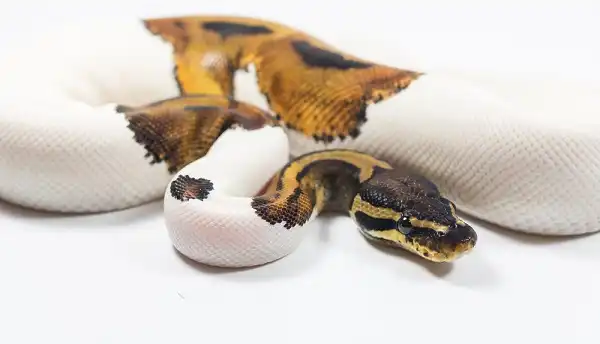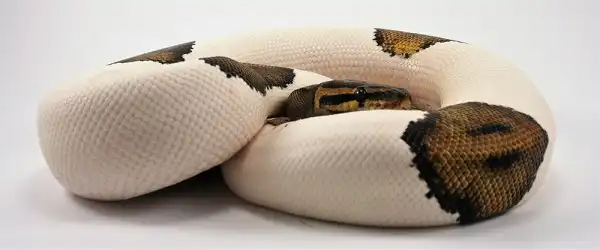Known for its calm demeanor and attractive color pattern, the Pied Ball Python is a popular choice among snake enthusiasts. This non-venomous species originates from the savannahs and light forests of western Africa and is typically great to handle due to its docile nature. If you are considering this beautiful serpent as your next pet, keep reading for an introduction to some of the basic facts about their care and habits.

Pied Ball Python Description
The Pied Ball Python is a striking creature, known for its patchwork of white and yellow scales contrasting against a deep black or brown backdrop. This coloration is a result of a genetic mutation and can vary greatly from one individual to another. In the wild, Pied Ball Pythons are typically found in the savannahs and light forests of western Africa, where they spend the majority of their time hiding in burrows or crevices. They are not aggressive by nature and are known for their docile temperament, making them a great choice for first-time snake owners. However, as with all snakes, it is important to handle them with care and respect. When it comes to care, the Pied Ball Python requires a temperature-controlled environment with a heat source and a hide box. They also need a source of water, which should be kept clean and fresh at all times. Due to their shy nature, they are not particularly active snakes and should be provided with plenty of hiding spots in their enclosure.
Pied Ball Python Habitat
The Pied Ball Python is a native of the savannahs and light forests of western Africa, where it inhabits a range of habitats from grasslands to rocky outcrops. This adaptable species is able to thrive in a variety of environments and can be found at elevations of up to 1,000 meters above sea level. In the wild, the Pied Ball Python spends much of its time hiding in crevices, burrows, or rock formations, waiting for prey to pass by. They are nocturnal creatures and are most active during the night, hunting for small mammals, birds, or reptiles. The Pied Ball Python is known to be a ground-dwelling species, but they will often climb trees or other structures in search of prey or bask in the sun. Their natural habitat is warm and dry, and they require a basking spot in their enclosure to mimic the natural warmth of the sun. If you are considering keeping a Pied Ball Python as a pet, it is important to provide them with a spacious, secure enclosure that mimics its natural habitat. A 20-30 gallon tank is suitable for a single adult, with ample hiding spots, climbing opportunities, and a basking area. The enclosure should be kept clean and at a consistent temperature of around 80-85°F, with a cooler area provided for the snake to regulate its body temperature.
Pied Ball Python Diet
The Pied Ball Python’s diet primarily consists of small mammals, such as mice and rats, as well as birds and invertebrates. In captivity, they are typically fed frozen or thawed mice or rats of an appropriate size, which can be purchased from pet stores or online suppliers. It is important to note that live prey should not be used for feeding, as this can pose a risk to the snake if the prey fights back. Additionally, feeding live prey can be stressful for the snake and may lead to a decline in its overall health. The frequency of feeding depends on the age and size of the snake. Younger snakes should be fed more frequently (about once a week), as they are still growing, while adult snakes only need to be fed about once every 2-3 weeks. Overfeeding can lead to obesity and other health problems, so it is important to monitor your snake’s weight and adjust its feeding schedule accordingly. It is also important to provide a source of clean, fresh water at all times, as dehydration can be a serious issue for snakes. The water should be changed regularly to prevent bacterial growth and other health risks.

Pied Ball Python Size
Pied Ball Pythons are relatively small snakes compared to other python species, with adults typically reaching lengths of about 3 to 4 feet. However, some individuals have been known to grow up to 5 feet, and even larger specimens have been reported on rare occasions. As with most snakes, female Pied Ball Pythons tend to be larger than males. Females can grow up to 5 feet in length, while males generally top out at around four feet. However, size varies greatly depending on the individual snake’s genetics and environmental conditions, such as diet and temperature. Overall, the size of the Pied Ball Python may not be as impressive as some other snake species, but they are still fascinating creatures that require specific care and attention in captivity. By understanding their size and behavior, you can provide a suitable home for your pet snake and ensure that they thrive for years to come.
Pied Ball Python Lifespan
The Pied Ball Python is a long-lived snake species, with a typical lifespan of around 20 to 30 years in captivity. However, some individuals may live well into their 40s with proper care and attention. Their lifespan in the wild is generally shorter than in captivity, as they are exposed to more environmental stressors and predation. In the wild, individuals may only live for 8 to 12 years. To ensure a long and healthy life for your pet Pied Ball Python, it is important to provide them with appropriate nutrition, housing, and veterinary care. Regular check-ups with a reptile veterinarian can help detect and prevent health issues early on, ensuring that your snake stays happy and healthy. Pied Ball Pythons also benefit from regular exercise and socialization, which can be achieved through supervised handling and supervised playtime outside of their enclosure. Providing them with plenty of climbing structures and hiding places in their enclosure can also help keep them mentally and physically stimulated. In summary, providing your Pied Ball Python with suitable habitat, balanced diet, and regular veterinary care can help ensure a long and healthy lifespan for this fascinating species. By understanding their natural history and unique needs, you can provide the best possible care for your pet snake and enjoy many happy years together.
Pied Ball Python Behavior
Pied Ball Pythons are known for their unique and fascinating behavior. These snakes are generally docile and make great pets, as they are relatively easy to care for and typically do not pose a threat to humans. One interesting behavior of the Pied Ball Python is its ability to curl up into a tight ball when threatened. This defensive behavior allows the snake to protect its head and vital organs from potential predators. They will also hiss and strike as a warning sign to any perceived threat. In addition, Pied Ball Pythons are known for their unique patterns and colors, which can vary greatly between individuals. This variation is due to the snake’s genetics, as well as environmental factors such as temperature and humidity. While Pied Ball Pythons may seem like solitary animals, they are actually quite social and enjoy the company of other snakes. In captivity, they can be kept together as long as they are of similar size and temperament.

Pied Ball Python Speed
When it comes to speed, Pied Ball Pythons are not known for their quick movements. Rather, they are slow and deliberate in their actions, relying on their camouflage and patience to catch prey. This is due to their nature as ambush predators, waiting for their prey to come to them rather than actively pursuing it. However, when it comes to striking at prey, Pied Ball Pythons can move surprisingly quickly. Their striking speed has been measured at up to 8 feet per second, allowing them to quickly and accurately take down their prey. In summary, while Pied Ball Pythons are not known for their speed, they are highly skilled hunters and can strike quickly when necessary. As pets, they do not require high levels of activity or exercise and are content to rest and move slowly.
Pied Ball Python Common Health Issues
Northern Water Snake, it is important to also understand any potential health issues that may arise. One of the more common health problems for these snakes is respiratory infections. Respiratory infections are caused by bacteria and viruses that can enter through wounds or be ingested from food items. Symptoms include wheezing, bubbling from the nostrils, anorexia, lethargy, and loss of weight. In order to prevent this infection, it is best to keep your snake’s environment clean and free of debris and make sure they are not exposed to drafts or cold temperatures. Additionally, providing adequate hydration through a shallow water bowl can also help prevent respiratory infections in Northern Water Snakes.
If you suspect your snake has a respiratory infection, contact a veterinarian immediately for further treatment. Another common health issue for Northern Water Snakes is parasite infestations. Parasites such as worms and mites can enter the body through food or by direct contact with other infected snakes. Symptoms include diarrhea, weight loss, lethargy, anorexia, and regurgitation. To prevent parasites in your snake’s environment it is important to provide routine cleaning and maintenance of their enclosure. Additionally, providing a balanced diet with fresh food sources that are free of parasites can help reduce the risk of infection. If you suspect your snake has been infected seek veterinary care immediately to treat the problem before it becomes severe.
Pied Ball Python Hunting
Pied Ball Pythons are skilled hunters and have unique hunting behavior. Being ambush predators, they wait for their prey to come to them rather than chasing them down. These snakes have evolved to rely on their camouflage, patience, and stealth to catch their prey. When hunting, Pied Ball Pythons will use their keen senses of smell, heat detection, and vibration detection to locate their prey. Once they have located it, they will slowly approach it and wait for the perfect moment to strike. The Pied Ball Python will then use its body to constrict the prey, squeezing it until it suffocates. Once the prey is dead, the snake will swallow it whole, sometimes taking days to fully digest it. Pied Ball Pythons are carnivorous and typically feed on small rodents such as mice and rats. In the wild, they may also hunt lizards, birds, and other small mammals. As pets, they are typically fed pre-killed rodents.

Conclusion
Pied Ball Pythons are a unique species of snake with distinct behavior and characteristics. Understanding their behavior and needs is essential for providing them with the best possible care in captivity. These snakes are ambush predators, relying on their camouflage, patience, and stealth to catch their prey. They move slowly and deliberately but can strike quickly when necessary. As pets, they require an appropriate enclosure that provides hiding spots, climbing opportunities, and limited exercise space. They also need to be provided with an enriching environment and ample opportunity to hunt in order to maintain their natural hunting behaviors.
Frequently Asked Question


